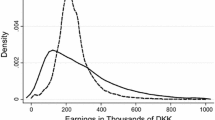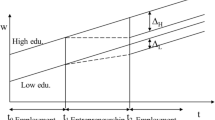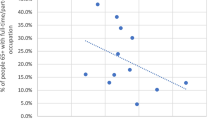Abstract
Academicians and policymakers have argued that entrepreneurship provides a route out of poverty and an alternative to unemployment or discrimination in the labor market. Existing research, however, provides little evidence from longitudinal data on the relationship between business ownership and economic advancement for disadvantaged groups. I use data from the National Longitudinal Survey of Youth (NLSY) to examine the earnings of young business owners from disadvantaged families and make comparisons to young wage/salary workers from disadvantaged families. For young men from disadvantaged families, I find some evidence that self-employed business owners earn more than wage/salary workers. In contrast, I find that for young women from disadvantaged families business owners earn less than wage/salary workers. The results from these earnings comparisons are somewhat sensitive to the use of different measures of income and econometric models.
Similar content being viewed by others
References
L. Aronson Robert (1991) Self-Employment: A Labor Market Perspective ILR Press Ithaca
Steven Balkin (1989) Self-Employment for Low-Income People Praeger New York
W. Baron Salo et al. (1985) Economic History of the Jews Schocken New York
Timothy Bates (1993) Assessment of State and Local Government Minority Business Development Programs U.S. Department of Commerce Washington, DC
Timothy Bates (1989) ArticleTitle‘The Changing Nature of Minority Business: A Comparative Analysis of Asian, Nonminority, and Black-Owned Businesses’ The Review of Black Political Economy 18 IssueIDFall 25–42
Timothy Bates (1990) ArticleTitle‘Entrepreneur Human Capital Inputs and Small Business Longevity’ The Review of Economics and Statistics 72 IssueIDNovember 551–559
Bates Timothy (1997). Race, Self-Employment & Upward Mobility: An Illusive American Dream. Washington, DC: Woodrow Wilson Center Press, and Baltimore: John Hopkins University Press.
J.M. Benus T.R. Johnson M. Wood N. Grover T. Shen (1995) Self-employment programs: A new reemployment strategy: Final report on the UI Self-Employment Demonstration (Unemployment Insurance Occasional Paper 95-4) U.S. Department of Labor, Employment and Training Administration, Unemployment Insurance Service Washington, DC
G. Blanchflower David Meyer Bruce D. (1994) ArticleTitle‘A Longitudinal Analysis of the Young Self-Employed in Australia and the United States’ Small Business Economics 6 IssueID1(February 1–19
Blanchflower, David G. and Andrew J. Oswald, 1998, ‘Entrepreneurship and the Youth Labour Market Problem’, OECD Report.
G. Blanchflower David Oswald Andrew J. (1998) ArticleTitle‘What Makes an Entrepreneur?’ Journal of Labor Economics 16 IssueID1 26–60
Edna Bonacich Modell John (1980) The Economic Basis of Ethnic Solicarity in the Japanese American Community University of California Press Berkeley
Borjas, George J., 1999, ‘The Wage Structure and Self-Selection into Self-Employment’, Harvard University working paper.
George Borjas (1986) ArticleTitle‘The Self-Employment Experience of Immigrants’ Journal of Human Resources 21 IssueIDFall 487–506
InstitutionalAuthorNameCenter for Human Resource Research (1997) NLSY79 Users’ Guide The Ohio State University Columbus, OH
A. Dunn Thomas Holtz-Eakin Douglas J. (2000) ArticleTitle‘Financial Capital, Human Capital, and the Transition to Self-Employment: Evidence from Intergenerational Links’ Journal of Labor Economics 18 IssueID2 282–305
David Evans Jovanovic Boyan (1989) ArticleTitle‘An Estimated Model of Entrepreneurial Choice Under Liquidity Constraints’ Journal of Political Economy 97 IssueID4 808–827
W. Fairlie Robert (2002) ArticleTitle‘Drug Dealing and Legitimate Self-Employment’ Journal of Labor Economics 20 IssueID3 538–567
W. Fairlie Robert (1999) ArticleTitle‘The Absence of the African-American Owned Business: An Analysis of the Dynamics of Self-Employment’ Journal of Labor Economics 17 IssueID1 80–108
W. Fairlie Robert Meyer Bruce D. (1996) ArticleTitle‘Ethnic and Racial Self-Employment Differences and Possible Explanations’ Journal of Human Resources 31 IssueIDFall 757–793
W. Fairlie Robert Meyer Bruce D. (2000) ArticleTitle’Trends in Self-Employment among Black and White Men: 1910–1990 Journal of Human Resources 35 IssueID4 643–669
Nathan Glazer Moynihan Daniel P. (1970) Beyond the Melting Pot: the Negroes, Puerto Ricans, Jews, Italians, and Irish of New York City EditionNumber2 MIT Press Cambridge
Cynthia Guy Doolittle Fred Fink Barbara (1991) Self-Employment for Welfare Recipients: Implementation of the SEID Program Manpower Demonstration Research Corporation New York
James Heckman (1990) ArticleTitle‘Varieties of Selection Bias’ American Economic Review 80 313–318
Holtz-Eakin, Douglas, David Joulfaian and Harvey Rosen, 1994, ‘Sticking It Out: Entrepreneurial Survival and Liquidity Constraints’, Journal of Political Economy, 53–75.
Douglas Holtz-Eakin Rosen Harvey S. Weathers Robert (2000) ArticleTitle‘Horatio Alger Meets the Mobility Tables’ Small Business Economics 14 243–274 Occurrence Handle10.1023/A:1008128521851
Michael Hout Rosen Harvey S. (2000) ArticleTitle‘Self-Employment, Family Background, and Race’ Journal of Human Resources 35 IssueID4 670–689
Cheng Hsiao (1986) Analysis of Panel Data Cambridge University Press Cambridge
Ivan Light (1972) Ethnic Enterprise in America University of California Press Berkeley
Ivan Light (1979) ArticleTitle‘Disadvantaged Minorities in Self Employment’ International Journal of Comparative Sociology 20 IssueID1–2 31–45
Ivan Light Rosenstein Carolyn (1995) Race, Ethnicity, and Entrepreneurship in Urban America Aldine de Gruyter New York
W. Loewen James (1971) The Mississippi Chinese: Between Black and White Harvard University Press Cambridge
Meyer, Bruce, 1990, ‘Why Are There So Few Black Entrepreneurs?’, National Bureau of Economic Research, Working Paper No. 3537.
Min, Pyong Gap, 1989, ‘Some Positive Functions of Ethnic Business for an Immigrant Community: Koreans in Los Angeles’, Final Report Submitted to the National Science Foundation, Washington, D.C.
Gap Min Pyong (1993) ‘Korean Immigrants in Los Angeles’ Light Ivan Bhachu Parminder (Eds) Immigration and Entrepreneurship: Culture, Capital, and Ethnic Networks Transaction Publishers New Brunswick
L. Moore Robert (1983) ArticleTitle‘Employer Discrimination: Evidence form Self-employed Workers’ Review of Economics and Statistics 65 IssueIDAugust 496–501
Salome Raheim (1997) ArticleTitle‘Problems and Prospects of Self-Employment as an Economic Independence Option for Welfare Recipients’ Social Work 42 IssueID1 44–53
Reardon, Elaine, 1997, ‘Are the Self-Employed Misfits or Superstars?’, working paper.
Hedley Rees Shah Anup (1986) ArticleTitle‘An Empirical Analysis of Self-Employment in the U.K.’ Journal of Applied Econometrics 1 IssueID1 95–108
Severens, C. Alexander and Amy J. Kays, 1999, 1999 Directory of U.S. Microenterprise Programs, Washington, DC: Aspen Institute.
Thomas Sowell (1981) Markets and Minorities Basic Books New York
U.S. Bureau of the Census 1993, 1990 Census of the Population, Education in the United States, CP-3-4, Washington, DC: Government Printing Office.
U.S. Bureau of the Census, 1997, 1992 Economic Census: Characteristics of Business Owners Washington, DC.: U.S. Government Printing Office.
U.S. Department of Labor, 1992, Self-Employment Program for Unemployed Workers. Unemployment Insurance Occasional Paper 92-2, Washington, DC: USGPO
Vroman, Wayne, 1997, ‘Self-Employment Assistance: Revised Report’, Urban Institute.
R. Williams Donald (2000) ArticleTitle‘Consequences of Self-Employment for Women and Men in the United States’ Labour Economics 7 IssueID5 665–687
Yuengert, Andrew M., 1996, ‘Left-Out Capital and the Return to Labor and Capital in Self-Employment’, Pepperdine University Working Paper.
Author information
Authors and Affiliations
Corresponding author
Rights and permissions
About this article
Cite this article
Fairlie, R.W. Entrepreneurship and Earnings among Young Adults from Disadvantaged Families. Small Bus Econ 25, 223–236 (2005). https://doi.org/10.1007/s11187-003-6457-5
Accepted:
Issue Date:
DOI: https://doi.org/10.1007/s11187-003-6457-5




